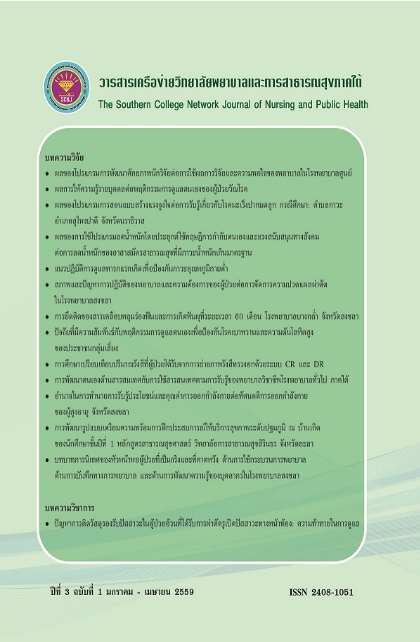การศึกษาเปรียบเทียบปริมาณรังสีที่ผู้ป่วยได้รับ จากการถ่ายภาพรังสีทรวงอกด้วยระบบ CR และ DR
คำสำคัญ:
ปริมาณรังสี, ภาพรังสีทรวงอก, การถ่ายภาพเอกซเรย์ระบบ CR, DR, Radiation Absorbed Dose, Chest Radiography/Chest X-Ray, Computed Radiography, Digital Radiographyบทคัดย่อ
งานวิจัยนี้เป็นการวิจัยเชิงพรรณนา มีวัตถุประสงค์เพื่อศึกษา 1) ปริมาณรังสีที่ผิวที่ผู้ป่วยได้รับจากการถ่ายภาพรังสีทรวงอก 2) เปรียบเทียบปริมาณรังสีที่ได้รับโดยจำแนกตามชนิดตัวรับภาพรังสี และ 3) เปรียบเทียบปริมาณรังสีที่ศึกษากับปริมาณรังสีอ้างอิงที่เป็นมาตรฐาน โดยเก็บรวบรวมข้อมูลจากกลุ่มตัวอย่างจำนวน 200 คน คือ ผู้มารับบริการทางรังสี ระหว่างวันที่ 1 กันยายน 2557 ñ 30 พฤศจิกายน 2557 โดยวิธีการสุ่มอย่างง่าย เครื่องมือที่ใช้ในการศึกษา ได้แก่ เครื่องเอกซเรย์เครื่องหมายการค้าชิมัสซึ รุ่น UD-150 L-40 E และเครื่องหมายการค้า โตชิบา รุ่น KXO-50F ตัวรับภาพระบบ DR ATAL 8Sensor A-Si TFT Array Flat Panel Detector เครื่องอ่านและแปลงสัญญาณภาพระบบ Computed Radiography (CR) แผ่น Plate เครื่องหมายการค้า iCR3600 เครื่องมือวัดความหนาทรวงอกผู้ป่วย และแบบบันทึกข้อมูล วิเคราะห์ข้อมูลโดย ใช้ค่าเฉลี่ย ส่วนเบี่ยงเบนมาตรฐาน ค่าร้อยละ ค่าThird Quartile และค่าเปรียบเทียบปริมาณรังสีที่ผิว โดยใช้สถิติที (t-test) ผลจากการศึกษาพบว่า
1. ปริมาณรังสีเฉลี่ยที่ผิวจากกลุ่มตัวอย่างผู้ป่วยที่ใช้ตัวรับภาพระบบ CR และ DR จากการถ่ายภาพรังสีทรวงอกเท่ากับ 0.64 และ 0.35 มิลลิเกรย์ ตามลำดับ
2. ชนิดตัวรับภาพต่างกันจะทำให้ผู้ป่วยได้รับปริมาณรังสีที่ผิวจากการถ่ายภาพทางรังสีทรวงอกแตกต่างกันอย่างมีนัยสำคัญทางสถิติ (t (198)=16.835, p< .001) โดยผู้ป่วยที่ได้รับการถ่ายภาพทางรังสีทรวงอกในระบบ CR จะได้รับปริมาณรังสีที่ Third Quartile 0.71 มิลลิเกรย์ (M=0.64, SD=0.15) สูงกว่าผู้ป่วยที่ได้รับการถ่ายภาพทางรังสีทรวงอกในระบบ DR ซึ่งจะได้รับปริมาณรังสีที่ Third Quartile 0.37 มิลลิเกรย์ (M=0.35, SD=0.09)
3. ปริมาณรังสีที่ผิวที่ผู้ป่วยได้รับจากการถ่ายภาพรังสีทรวงอกในระบบ CR สูงกว่าเกณฑ์องค์การมาตรฐานอ้างอิงระหว่างประเทศ (0.4 มิลลิเกรย์) อย่างมีนัยสำคัญทางสถิติที่ระดับ .001 ในขณะที่ปริมาณรังสีที่ผิวที่ผู้ป่วยได้รับจากการถ่ายภาพรังสีทรวงอกในระบบ DR ต่ำกว่าเกณฑ์องค์การมาตรฐานอ้างอิงระหว่างประเทศ (0.4 มิลลิเกรย์) อย่างมีนัยสำคัญทางสถิติที่ระดับ .001 โดยใช้ค่าThird Quartile ในการเปรียบเทียบ
Comparison of Radiation Absorbed Doses among Patients Undergoing Standard Chest Radiographic Examination by Computed Radiography (CR) and Digital Radiography (DR)
The purposes of this descriptive research were to: 1) study radiation absorbed dose among patients undergoing standard chest radiographic examination, 2) compare the radiation absorbed doses between types of imaging receptor, and 3) compare the radiation absorbed doses and the standard reference doses. Data were collected from 200 samples who attended the radiography unit of Songkhla hospital during the period of September 1st – November 30th, 2014. Simple random sampling was used. Research instruments included: 1) three X-ray machines, namely Shimaszu brand models UD-150 and L-40 E, and Toshiba model KXO-50F, 2) imaging receptor system DR ATAL 8Sensor a-Si TFT Array Flat Panel Detector, 3) reader and converter machine with Computed Radiography (CR) system, 4) i CR3600sheet plate, 5) chest thickness measurement tool, and 6) record form. Data were analyzed using mean and standard deviation, percentage, third quartile value, andt-test.
The results from this study revealed the following.
1.The average radiation absorbed doses measured from skin of the samples undergoing chest X-Ray and using the image receptors, CR and DR systems, were 0.64 and 0.35 milligray, respectively.
2. The difference in the radiation absorbed doses between using the imaging receptors, CR and DR system, was statistically significant (t (198)=16.835, p< .001). Samples undergoing chest X-Ray in CR system absorbed radiation dose 0.71 milligray at the third quartile (M=0.64, SD=0.15) that was higher than undergoing the DR system (the radiation absorbed dose=0.37 milligray at the third quartile; M=0.35, SD=0.09).
3. The radiation absorbed dose measured on skin of samples undergoing the chest X-Ray using CR system was statistically significant, it is to say higher than the value indicated by the international organization for standard reference (0.4 milligray) at a level of 0.001. Whereas, using DR system was statistically significant, it is to saylower than the value indicated by the international organization for standard reference (0.4milligray) at a level of 0.001. The third quartile value was used in the comparison.
ดาวน์โหลด
เผยแพร่แล้ว
ฉบับ
ประเภทบทความ
สัญญาอนุญาต
1. บทความหรือข้อคิดเห็นใด ๆ ที่ปรากฏในวารสารเครือข่าย วิทยาลัยพยาบาลและการสาธารณสุขภาคใต้ ที่เป็นวรรณกรรมของผู้เขียน บรรณาธิการหรือเครือข่ายวิทยาลัยพยาบาลและวิทยาลัยการสาธารณสุขภาคใต้ ไม่จำเป็นต้องเห็นด้วย
2. บทความที่ได้รับการตีพิมพ์ถือเป็นลิขสิทธิ์ของ วารสารเครือข่ายวิทยาลัยพยาบาลและการสาธารณสุขภาคใต้








